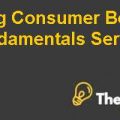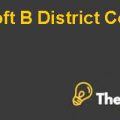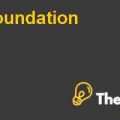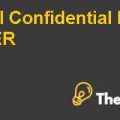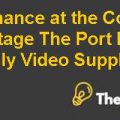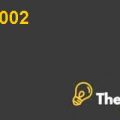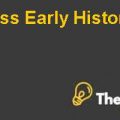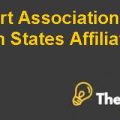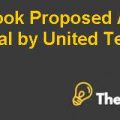Capstone Project Case Study Analysis
If thecompany decides to convert the PPE to IFRS;itshould contact a CPA that specializes in international tax to discuss the options that thecompany hasfor the PPE accounting If thecompany is unsure as to how to do this then it should seek a professional accountant with specialization in international tax so that he could guide the company through the process.
When convertingthe PPE to IFRS, the company would also require to change the GAAP-based reconciliation process, to include a new IFRS-based reconciliation process. The company should make sure the make all of the necessary changes to the GAAP-based reconciliation process in order to sure that all of the transactions are being properly accounted for.
If thecompany does not plan to convert the PPE to IFRS; itt should continue with the current GAAP-based reconciliation process to possible extent. Although,thecompany may want to continue the usage of IFRS-based reconciliation; it shoulduse a qualified CPA to help with this task.
Forthe plan of convertingthe PPE to IFRS, thecompany should also review the new international accounting standards that are currently in place. This can help thecompany to determine what changes are required to be made inthe accounting methods in order to be compliant with the new standards.
In addition to the changes in accounting methods, they also need to make sure that they have bookkeeping systems in place, in order to be aligned with the new accounting methods that are currently in place, with new international accounting standards. Thecompany should consider using the accounting software that is available to help in keeping all of the accounting records up to date.
Area by area analysis of GE
The cost of the property, plant and equipment of the General Electric is generally depreciated using the straight line depreciation method over its estimated economic life. The cost of the capital equipment of theGeneral Electric which are leased to others on operating leases is depreciated on the straight line basis for the purpose of estimating the residual value over the estimated economic life of the equipment and over the lease term.
Project implementation plan
With core consideration over gaining the greatest advantage from the adoption of the International Financial Reporting Standards (IFRS), General Electric Company needs to take the comprehensive and methodical approach that tend to look beyond simple regulatory compliance to the broader set of opportunities and business challenges. The transition from GAAP to the IFRS most likely requires the operational, strategic and tactical changes. By focusing on effectively complete the conversion process; the company needs to follow the major phases of the procedure, which are as follows:
Diagnosis
The diagnosis is the first phase of the conversion process, in which the company needs to assess the readiness for the IFRS. As the impact of the IFRS is far beyond the accounting department, the assessment should address each and every part of the organization that plays a role in transitioning to the IFRS. Several of the particular focus are discussed below:
IFRS specific skills
In case the IFRS specific skills are available in the organization, and if not, the best way to get access to the skills includes specialized vendors as well as enterprise software vendors, such as: training firms and accounting firms, which have the IFRS practices.
Training
The provision of the training is of high importance across the firm for the purpose of supporting the transition effort. Many employees have part-time responsibility for the transition to the IFRS that stems from their core responsibilities. The activities comprise test requirements, auditing and creation of the procedures and re-keying of information.
Financial instrument
The company needs to diagnose the impact of the financial instrument on the business operations. With the substantial changes in the reportable position, which could potentiallybe triggered by the adoption of the IFRS, the company needs to ensure that there would be the business case for the changing business operations.
Development
With the readiness and willingness of the company for the adoption of the IFRS; the development of the strategies is the next step of the transition process to IFRS that each and every part of the business would be required to implement. The phase should be action-focused and more-detailed as compared to the diagnose phase.
Financial management
The company needs to develop specific plans for aligning covenant ratios and hedging strategies with the IFRS. The certain changes in the financial reporting, integration changes, analysis codes, and account structures should be developed.
Communication
As with any little change in the management activity, the comprehensive, clear, prompt external and internal communication is required for the transition to IFRS. Furthermore, the company needs to communicate the progress in transitioning to the IFRS from GAAP to the government regulatory officials, press, banks and shareholders. It is significantly important for the company to involve the existing communication infrastructure in the diagnose phase, so the communication strategies could be created and implemented as soon as the development stage starts.
Supporting technology
Invariably, a number of changes in the communication, human resource, financial management as well as other business processes would require the particular modifications in the information technology infrastructure. This phase is the time for determining the several ways through which the IT system of the company needs to change and start the process for an effective and successful implementation of these changes.
Delivery
The development of specified business in relation to IFRS are known to represent the changes that are to be followed by a Delivery phase. In this phase, the organization requires the implementation of compliance strategies of IFRS. This represents the requirement of differentiated steps.
Testing:
The testing of the modified process of the business is to make sure that correct information is being captured and processed in an appropriate manner.
Comparatives:
Considering the transition of IFRS from US GAAP, there is a requirement of a report that represents the business performance followed by the use of both standards of past year. A formal comparative period has been outlined by the regulators of the US and Canada,as a key part of their respective strategic approaches of transition.
Reporting
The transitioning of IFRS of GE in countries other than the United States;the reporting process is considered to be flexible. Rigid reporting based on the spreadsheet on the prescriptive model lacks the provision of support to the multiple requirements of reporting. A solution to performance management tends to be associated with the traceability and integration with the differentiated systems of transaction,in order to achieve the flexibility in reporting, which is required both during and after the IRFS transition.
Auditing
The final step in this phase is associated with the review and confirmation of external auditors that is changes by the process leading of compliance of IRFS.
Research difference
Accounting differences between GAAP and IFRS are so vast that one has to be an exceptionally good accountant to figure out which is which. So what exactly is a difference of accounts and how does one decide between the two? For instance, what are the differences of GAAP and IFRS? If thecompany does not know the answer to this question; it needs to find a good accounting firm or a GAAP accountant.
The differences between GAAP and IFRS are mainly due to the fact that IFRS is an international agreement between countries and accounting firms. IFRS is a very different way of accounting. It was actually developed by the United States.
The GAAP accounting system of accounting, however, is based on the general concepts of the US GAAP. However, there are some differences between the two. These differences include the fact that IFRS is based on IFRS. So even if one uses the terminology of the US GAAP to describe an accounting statement, one can still refer to IFRS or European Accounting Standard for an accounting statement.
One of the major differences between the two methods is the pricing mechanism. The pricing mechanism is quite different between the two. IFRS is based on the pricing mechanism of two currencies. The prices of goods and services are affected by the different values of currencies and the effect of these values on the cost of the product.
One of the major differences between the two, is the accounting treatment. IFRS has more than a single set of accounting rules. In addition, it has a double taxation regime. It has double taxation on dividends and multiple taxation on interest, so that the accounting treatment is basically a two-step process.
One of the other differences between the two is the type of reporting that is done by a company or a firm that uses the GAAP. If thecompany is an American company and it wants to deal with a European company;the company would have to follow the rules of GAAP and then the company would have to use a European accounting standard to deal with the European company.
Another difference is the type of accounting statements that are used. Both the US and the European accounting standards do not have a single type of bookkeeping method. The United States has a double entry bookkeeping system, while the European system is a single entry bookkeeping method. If thecompaniesare dealing with a European company; they need to use the single-entry bookkeeping method. In addition, thecompany would have to use the standard bookkeeping system when dealing with an American company.
In conclusion, one can say that both the IFRS and GAAP have some differences. These differences are mainly based on the type of accounting methods that one uses to report and interpret the financial statements. The two different methods have their own set of rules and procedures. If one chooses the right company or the right accountant; they would be able to choose the best method.
In case of the European accounting method; the companies and the firms that use this method have a better chance of getting their products and services listed in the stock exchange in the US as well as in other European countries. The main disadvantages of this method are the difference of the prices of the products and the services are not only based on the two countries. It is also based on the two different standards. In order to be able to use this method, thecompany will have to be prepared to get a second passport in order to be able to deal with the European companies that use this method.
Another disadvantage of this method is that the companies and the firms that use this method, cannot use the difference of the prices of the products and the services in the different countries for the purpose of setting up a base of the pricing of the products and the goods as well as the services of the country where the products are being sold. If the pricing is set in the US and the pricing is set in the European country; there is a possibility of the pricing being different in both the countries. If one decides to set up a base for the pricing in the US; it would be difficult to transfer this pricing information to the European countries, because of the differences in the rules of the two companies.
In the case of the IFRS; the companies and the firms that use this method have a better chance of setting the base of the pricing based on the differences between the two countries. The disadvantage is that the pricing can be set in both the countries, based on the differences in the rules of the two countries. The advantage of this method is that the pricing can be set in one country and transferred to the other country, but there is no chance of a transfer.
The differences between the two methods, are mainly based on the type of accounting method that is being used. One of the differences between the two methods is the choice of the base of the pricing of the products and the goods and the services of the country where the goods and the services are being sold. If the pricing is set in the US and the pricing is set in the European country, there is a possibility of the pricing being different in both the countries. If one decides to set up a base for the pricing in the US; it would be difficult to transfer this pricing information to the European countries, because of the differences in the rules of the two countries.
Obstacles to executing the project plan
In complying with the standards of IRFS, there is a requirement of a number of changes in terms of accounting departments for the collection, classification, and representation of the financial data. One of the biggest challenge and change associated with the execution of businesses of the United States operating under IFRS, which is primarily required to be followed by two mutual and distinctly exclusive set of guidelines. This is mainly due to the requirement for the use of GAAP guidelines in case they are reported to the Securities and Exchange Commission. The reporting of accounts like the separation of inventory between the two different standards. For instance, difference in valuations tends to result in different values for the expense and net income under either set of standards. This represents the requirement for GE to either consider the hiring of additional staff for accounting purpose or to spend two double amount of time to prepare the financial reports.
Similarly, the representation of major challenges that tend to greatly influence the way how businesses in the United States, are represented in terms of inventory and assets. Under IFRS, the first-out method in terms of inventory costing is known to be prohibited. For instance, this would lead to a significant change in the way how the business in the United States’ accounts for its inventory. Additionally, writing-down of inventory values are considered not to be reserved under the IFRS representing the challenge that is accustomed to adjust the values of inventory on regular basis. Considering the accounting for asset depreciation; it represents the requirement of change and a business approach accounting the components of depreciation separating from equipment depreciation as a whole under specified circumstances.
Concluding comments
At last, it has been concluded that the company should not go with the new model, because it will decrease its balance sheet value (net worth) from $ 266,048 to $ 261,864............................
This is just a sample partical work. Please place the order on the website to get your own originally done case solution.

